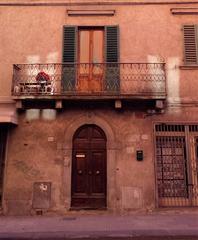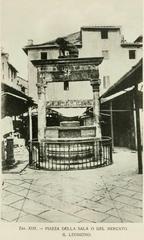Ecomuseum Of The Pistoiese Mountains Itinerary Of Daily Life. Giamba And Berto'S Mill And The Charcoal Route
Ecomuseum of the Pistoiese Mountains: Visiting Hours, Tickets, and Guide to Historical Sites
Date: 14/06/2025
Introduction to the Ecomuseum of the Pistoiese Mountains
Set amidst the rolling Tuscan Apennines, the Ecomuseum of the Pistoiese Mountains (Ecomuseo della Montagna Pistoiese) is a pioneering example of community-driven heritage preservation. Founded in 1990 as Italy’s first ecomuseum, it weaves together the tangible and intangible heritage of its mountain communities, encompassing historical sites, enduring traditions, and the natural landscape (tuscanymountain.it). Unlike conventional museums, the Ecomuseum is defined by its open-air network of thematic itineraries and participatory experiences.
This guide presents essential information for planning your visit—covering opening hours, ticketing, accessibility, thematic routes, local culture, and practical tips. Whether you are a history enthusiast, nature lover, or cultural traveler, the Ecomuseum offers an immersive journey into the past and present of the Pistoiese Mountains.
Contents
- Introduction
- Historical Background
- Thematic Itineraries
- The Itinerary of Daily Life
- Other Routes and Experiences
- Visitor Information
- Hours and Tickets
- Accessibility
- Getting There and Facilities
- Practical Tips
- FAQs
- Community and Cultural Significance
- Visual and Interactive Resources
- Contacts and Further Information
- Conclusion and Recommendations
- Sources
Historical Background
Origins and Development
The Ecomuseum was established by the Province of Pistoia to safeguard and interpret the region’s unique environmental and cultural heritage. Inspired by the ideas of museologist Hugues de Varine, its approach centers on connecting people, place, and memory. Since 2015, the Ecomuseum has held regional accreditation and is headquartered at Palazzo Achilli in Gavinana—a Renaissance building that also serves as an exhibition space and visitor center (ecomuseopt.it).
The Ecomuseum’s philosophy places community participation at its core, with local residents curating and managing sites, organizing events, and transmitting traditions to new generations (Chang et al., 2015).
Thematic Itineraries: Exploring Mountain Heritage
The Ecomuseum is structured around six thematic itineraries, each revealing a different facet of mountain life and history (visittuscany.com).
The Itinerary of Daily Life: Chestnuts, Mills, and Charcoal
This route offers a window into the everyday rhythms and ingenuity of the mountain communities, focusing on three main elements:
1. Chestnut Culture
Chestnut trees have long been vital to local sustenance. Historic drying sheds (metati or seccatoi) demonstrate how chestnuts were slow-dried over 40–50 days, then milled into flour—a staple of regional cuisine (visitpistoia.eu).
2. Giamba and Berto’s Mill
The restored Molino di Giamba, dating to 1820, showcases the water-powered milling of chestnuts using unique horizontal millwheels. Visitors can observe traditional milling in action during seasonal demonstrations. Nearby, Molino di Berto serves as a meeting point, restaurant, and shop for local products (visitpistoia.eu; Indiana Gio).
3. The Charcoal Route
The Via del Carbone explores the demanding craft of charcoal production. Authentic reconstructions of a charcoal burner’s hut (capanna del carbonaro) and kiln (carbonaia) illustrate the process and its significance for local industries (visitpistoia.eu).
Integration with the Landscape: The route features scenic forest trails and two self-supporting wooden bridges inspired by Leonardo da Vinci’s designs, offering both historical and architectural interest (brunelleschi.imss.fi.it).
Other Thematic Routes
Beyond daily life, the Ecomuseum’s itineraries include:
- Ironworks Route: Medieval iron production and smithing sites.
- Ice Route: Historic icehouses and harvesting traditions.
- Sacred Art, Nature, and Stonework Routes: Churches, natural sites, and stonecraft. Each offers interpretive signage, interactive workshops, and opportunities for guided exploration (visittuscany.com).
Visitor Information
Hours and Tickets
- Palazzo Achilli (Gavinana Information Center): Tuesday–Sunday, 9:30 AM–6:00 PM. Closed Mondays and public holidays.
- Outdoor Sites and Trails: Open year-round; some activities and interior visits are seasonal (mainly May–October). Check the official website for current schedules.
- Entry Fees: Most outdoor routes are free. Guided tours and workshops typically require a fee (€5–€15). Booking is recommended for groups and events.
Accessibility
- Mobility: The main center is wheelchair accessible; outdoor trails are moderately challenging and may not be suitable for wheelchairs or strollers.
- Facilities: Rest areas, interpretive panels, and picnic spots are present, but services vary by location.
Getting There and Facilities
- By Car: From Pistoia (city), follow SP633 to Orsigna (approx. 45–60 minutes).
- Public Transport: Limited; regional buses serve nearby towns, but car travel or organized tours are more convenient (Visit Tuscany).
- Parking: Available in Orsigna village, with clear signage to trailheads.
- Amenities: Restrooms in Orsigna; bring water and snacks as there are no shops on most trails.
Practical Tips
- Footwear: Wear sturdy shoes; trails can be uneven and slippery after rain.
- Weather: Dress in layers; mountain weather is variable.
- Seasonality: Best visiting months are May–October. Chestnut harvest and related festivals occur in autumn.
- Photography: Early morning or late afternoon provides the best light for the Leonardo bridges and landscapes.
- Local Products: Buy chestnut flour or local honey at Molino di Berto or village shops.
Community and Cultural Significance
The Ecomuseum stands out for its community-centered approach. Residents are directly involved in curating exhibits, leading tours, and organizing events, ensuring the preservation of both material and intangible heritage (Chang et al., 2015). The model fosters local pride, supports small businesses, and strengthens social ties through festivals, educational programs, and intergenerational storytelling (Italia Like a Local).
Visitors are encouraged to actively engage: participate in hands-on workshops, converse with locals, and support artisans by purchasing products directly.
Frequently Asked Questions (FAQ)
Q: What are the visiting hours?
A: Palazzo Achilli is open Tuesday–Sunday, 9:30 AM–6:00 PM. Outdoor routes are accessible year-round; interior site hours may vary seasonally.
Q: Are guided tours available?
A: Yes. Local guides (often identified by red vests) offer tours and demonstrations, especially on weekends and during special events. Booking is advised.
Q: Is the Ecomuseum accessible for people with disabilities?
A: The information center is accessible; outdoor trails are not fully accessible due to terrain.
Q: Are dogs allowed?
A: Yes, on leash.
Q: How do I book workshops or tours?
A: Reserve via the official Ecomuseum website or at Palazzo Achilli.
Visual and Interactive Resources
Explore the Ecomuseum’s online gallery for images and videos of sites like Giamba and Berto’s Mill, the Charcoal Route, and the Leonardo da Vinci bridges. Interactive maps and virtual tours are available to help plan your visit (visitpistoia.eu).
Contacts and Further Information
- Ecomuseum Association: Associazione Ecomuseo della Montagna Pistoiese, Piazzetta Achilli 7, Gavinana (PT)
- Information Point: Palazzo Achilli
- Phone: +39 0573 638025
- Email: [email protected]
- Official Website: www.ecomuseopt.it
- Tourism Portal: Visit Pistoia
Conclusion and Recommendations
The Ecomuseum of the Pistoiese Mountains is a living testament to Tuscany’s mountain heritage. Through its thematic itineraries, hands-on workshops, and community-led events, it offers visitors a rare chance to witness traditional crafts, explore scenic landscapes, and connect with the rhythms of rural life. Its sustainable, community-focused model ensures that tourism benefits local residents and preserves authentic traditions (Italia Like a Local).
Plan your visit today:
- Check opening hours and book tours in advance.
- Download the Audiala app for interactive guides and offline maps.
- Participate in seasonal festivals and hands-on workshops.
- Support the local community by purchasing artisanal products and sharing your experiences.
Share your journey using #PistoieseEcomuseum on social media and help celebrate Tuscany’s living heritage.
Sources and Further Reading
- Ecomuseo della Montagna Pistoiese: A Journey to Discover the Memory of the Territory (tuscanymountain.it)
- Le castagne della montagna pistoiese e il Molino di Giamba (visitpistoia.eu)
- Chang et al., 2015: Community-Centered Heritage
- The Eco-museum of the Montagna Pistoiese (Visit Tuscany)
- Italia Like a Local: 10 Travel Tips to Explore Italy Like a Local
- Pistoia and the Pistoia Mountains (Visit Tuscany)

